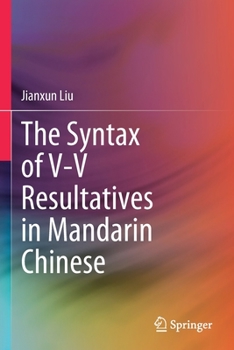The Syntax of V-V Resultatives in Mandarin Chinese
Select Format
Select Condition 
Book Overview
Chapter 1: Introduction 1 The empirical domain and basic research questions 2 Arguments and proposals: Preview 2.1 The generation of V-V resultative compounds 2.2 The syntactic structure of V-V resultatives 2.3 The alternation properties of V-V resultatives 3 Theoretical assumptions 4 Outline of the dissertation
Chapter 2: The generation of resultative V-V compounds 1 Introduction 2 Lexicalist vs. syntactic approaches to word formation 2.1 The lexicalist approach 2.2 Word formation in Distributed Morphology: A syntactic approach 3 The inner vs. outer domain hypothesis for the formation of complex words 3.1 The inner vs. outer domain hypothesis 3.2 The crosslinguistic application of the two-domain hypothesis 4 A lexicalist analysis: Y. Li (2005) 5 Generation of resultative and parallel V-V compounds in Mandarin 5.1 Resultative vs. parallel V-V compounds 5.1.1 Parallel V-V compounds 5.1.2 Contrasting properties of resultative and parallel V-V compounds 5.2 An analysis under the two-domain hypothesis 5.2.1 Semantics: Compositionality vs. idiosyncrasy 5.2.2 Nominalizations 5.2.3 Free vs. bound component morphemes 5.2.4 Productivity vs. semi-productivity 5.2.5 Adverbial modification 6 Conclusion
Chapter 3: The syntactic structure of Mandarin V-V resultatives: An event-mapping
approach 1 Introduction 2 The event-mapping approach to argument structure 2.1 Lexicalist vs. syntactic approaches to argument structure 2.1.1 The lexicalist approach 2.1.2 The syntactic approach: The autonomy of syntactic structure 2.2 The event-mapping approach to argument structure 2.2.1 Event-structure decomposition of verbal semantics 2.2.2 The event-mapping approach to argument structure 2.2.2.1 Travis (2010) and Ramchand (2008) 2.2.2.2&nbs
Chapter 2: The generation of resultative V-V compounds 1 Introduction 2 Lexicalist vs. syntactic approaches to word formation 2.1 The lexicalist approach 2.2 Word formation in Distributed Morphology: A syntactic approach 3 The inner vs. outer domain hypothesis for the formation of complex words 3.1 The inner vs. outer domain hypothesis 3.2 The crosslinguistic application of the two-domain hypothesis 4 A lexicalist analysis: Y. Li (2005) 5 Generation of resultative and parallel V-V compounds in Mandarin 5.1 Resultative vs. parallel V-V compounds 5.1.1 Parallel V-V compounds 5.1.2 Contrasting properties of resultative and parallel V-V compounds 5.2 An analysis under the two-domain hypothesis 5.2.1 Semantics: Compositionality vs. idiosyncrasy 5.2.2 Nominalizations 5.2.3 Free vs. bound component morphemes 5.2.4 Productivity vs. semi-productivity 5.2.5 Adverbial modification 6 Conclusion
Chapter 3: The syntactic structure of Mandarin V-V resultatives: An event-mapping
approach 1 Introduction 2 The event-mapping approach to argument structure 2.1 Lexicalist vs. syntactic approaches to argument structure 2.1.1 The lexicalist approach 2.1.2 The syntactic approach: The autonomy of syntactic structure 2.2 The event-mapping approach to argument structure 2.2.1 Event-structure decomposition of verbal semantics 2.2.2 The event-mapping approach to argument structure 2.2.2.1 Travis (2010) and Ramchand (2008) 2.2.2.2&nbs
Format:Paperback
Language:English
ISBN:9813368489
ISBN13:9789813368484
Release Date:March 2022
Publisher:Springer
Length:125 Pages
Weight:0.44 lbs.
Dimensions:0.3" x 6.1" x 9.2"
Related Subjects
Language ArtsCustomer Reviews
0 rating





